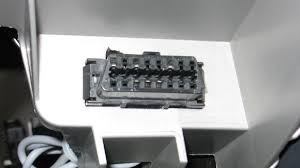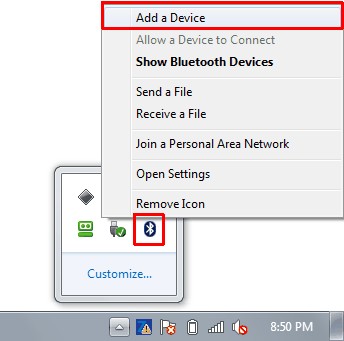Diagnosing your car’s health has never been easier, thanks to OBDII Bluetooth scanners. These handy devices, when paired with your Windows computer, can unlock a wealth of information about your vehicle’s performance and potential issues. This guide will walk you through the process of connecting your ELM327 Bluetooth OBD scanner to your Windows system, allowing you to use powerful OBD-II software for vehicle diagnostics.
Step 1: Locate the OBDII Port in Your Vehicle
The first step is to physically connect your OBDII Bluetooth scanner to your car. The OBDII port, or On-Board Diagnostics II port, is standardized across most modern vehicles.
It typically looks like this:
Image showing a close-up of an OBDII port connector, highlighting its trapezoidal shape.
And is usually located here:
You’ll generally find it beneath the steering wheel on the driver’s side dashboard. If you’re having trouble locating it, a helpful online resource to pinpoint its exact location is the Installernet Fit Guide.
Step 2: Turn On Your Car’s Ignition
Before proceeding with the Bluetooth pairing, turn your car’s ignition to the “ON” position. This is the position right before you start the engine. This step is crucial as it powers up the OBDII port and allows the scanner to communicate with your vehicle’s computer system.
Step 3: Pair Your ELM327 Bluetooth Scanner with Windows
Now, let’s move to connecting the Bluetooth scanner to your Windows computer.
- Initiate Bluetooth Device Addition:
Right-click the Bluetooth icon in your Windows taskbar (usually in the bottom right corner of your screen) and select “Add a Device”.
- Select Your OBDII Bluetooth Device:
Windows will now scan for Bluetooth devices in range. Your ELM327 scanner should appear in the list. It might be listed under various names such as “OBDII”, “OBD-II”, “VLink”, or “Can OBDII”. Select the device to begin pairing.
Note: It may take up to 15 seconds for the Bluetooth signal from the OBDII scanner to become visible in the list. Ensure your scanner is properly plugged into the OBDII port and the car ignition is ON.
Troubleshooting Signal Detection:
If the device signal does not appear:
1. **Rescan:** Exit the "Add a Device" screen, disconnect the ELM327 Bluetooth scanner from your car's OBDII port, reconnect it, and try "Add a Device" again. 2. **Restart:** If rescanning doesn't work, restart your Windows computer and repeat the "Add a Device" process. 3. **Check Bluetooth Devices:** If you have previously paired the device, it might not reappear in "Add a Device". In this case, look for it under "Show Bluetooth Devices" in the Bluetooth settings.As long as the red power light on your ELM327 Bluetooth scanner is illuminated, it indicates the device is receiving power and should be detectable by your computer.
Screenshot of the Windows “Add a device” window highlighting an example of an ELM327 Bluetooth OBDII device being listed.
- Enter the Pairing Code:
When prompted for a pairing code, enter the following:
Pair code: 1234 If the above doesn't work, try: 0000For older Windows XP systems, you may see an option like “Use the passkey found in the documentation.” In this case, use the codes provided above.
Additional Step for Windows XP Users
Once the pairing is successful, Windows will display the COM port numbers assigned to the Bluetooth connection.
Screenshot showing the successful Bluetooth pairing confirmation with COM port numbers displayed, specifically highlighting the outgoing COM port.
Important: Note down the number of the Outgoing COM port. You will need this COM port number later to configure your OBD software to communicate with the ELM327 scanner.
Step 4: Launch OBD Software and Connect to Your Vehicle
With the Bluetooth connection established, you’re now ready to use OBD software to communicate with your car.
Launch your preferred OBD-II software on your Windows computer. For optimal compatibility and advanced features, we recommend professional software like TOAD (Total OBD & ECU Auto Diagnostics), which is fully compatible with Bluetooth OBDII scanners.
Within your OBD software, navigate to the connection settings. Select the Bluetooth connection type and choose the Outgoing COM port number you noted down in the previous step. Click “Connect” or a similar button within your software to establish a connection with your vehicle’s ECU (Engine Control Unit) through the ELM327 Bluetooth scanner.
Troubleshooting Connection Issues
If your OBD software encounters difficulties connecting to your car, a common solution is to adjust the baud rate of the connection.
Many OBD software programs offer an option to set the baud rate in their settings. Try setting it to 9600 or 110 bits per second. TOAD software, for example, includes a setting to force a 9600 bps connection, which can resolve intermittent disconnection problems.
Adjusting Baud Rate in Windows Device Manager (If Software Option Not Available):
If your OBD software lacks the option to adjust the connection speed, you can manually limit it through Windows Device Manager settings.
Access Device Manager:
- Windows Vista/7/8/10: Right-click on the Windows “Start” button, select “Device Manager”. Alternatively, go to Control Panel » System and Security » System » Device Manager.
- Windows XP: Control Panel » System » “Hardware” tab » Device Manager » Ports (COM & LPT).
Locate Bluetooth COM Port:
Expand the “Ports (COM & LPT)” section in Device Manager. Look for “Standard Serial Bluetooth” or a similar name that corresponds to your ELM327 Bluetooth connection.
Adjust Port Settings:
Right-click on the Bluetooth COM port and select “Properties”. Go to the “Port Settings” tab.
Lower Baud Rate:
In the “Port Settings” tab, reduce the “Bits per second” value to 110. Click “OK” to save the changes.
Screenshot of Windows Device Manager, Port Settings tab, showing the “Bits per second” option being adjusted to a lower value for Bluetooth COM port.
After adjusting the baud rate, attempt to reconnect to your car using your OBD software.
By following these steps, you should be able to successfully connect your OBDII Bluetooth scanner to your Windows computer and start diagnosing your vehicle with compatible OBD-II software.
| Resources: |
|---|


